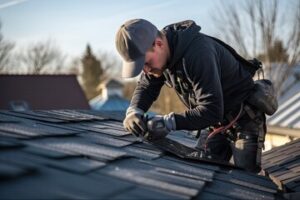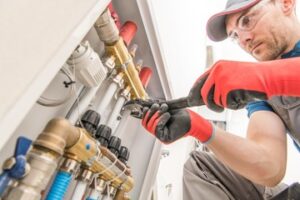It takes a lot to keep your roof in tip-top shape. Even so, it’s likely that you will face Corpus Christi Roof Repair at some point.

Budget-conscious homeowners hope that their roof will only need patching rather than replacement. Unfortunately, the reality is often more complicated than that. To make the right decision, you need to carefully assess your damage and take a look at the following:.
The shingles on your roof provide the first line of defense against rain, snow, and other elements that can damage your home. When installed correctly, shingles act in a unique layering pattern to keep your house dry and warm. But like all materials, shingles will eventually need to be replaced. If you don’t make the necessary repairs, your roof could become leaky and unsafe.
The most common roof repair is replacing a damaged or missing shingle. In addition to replacing a single shingle, it’s also important to examine the area around it for signs of damage or other issues that need attention. Look for cracks, holes, bare spots, or areas where the roof is soft or sagging.
If you notice any of these issues, it’s a good idea to contact a professional roofer to determine the proper course of action. Depending on the extent of the damage, you may need to replace large sections of your roof or simply perform a minor repair.
Over time, shingles get battered by the weather that hits them, causing them to degrade. When this happens, the granules that protect the asphalt layer can start to erode or become dislodged. Those bare spots on your roof can expose your home to water damage and make it more susceptible to fire damage.
One of the most obvious symptoms of a damaged or missing shingle is water stains in your ceilings and walls. Water stains are an indicator of roof leaks, which can lead to serious structural damage and expensive water bills over time.
To check for leaks, use a ladder to access the roof and carefully inspect each section. Look for sagging or soft spots, which are areas where the shingles are loose and can allow rainwater or snow to seep underneath. Also look for moss and algae growth, which indicate that the roof’s protective vapor barrier is compromised.
When a shingle gets damaged or loses its granules, it’s important to replace it quickly to prevent moisture penetration and other problems. To replace a shingle, first use a flat pry bar to break the glue seal that holds it down. Then, locate the nail that runs through the shingle and remove it. Be sure to search for and remove the nails from the shingles above it as well. Finally, reseal the base of your new shingle with a bead of roof sealant.
Flashing
Flashing is a strip of metal that prevents water damage by directing rainwater away from the vulnerable points of a roof. These include the seams, joints, and edges of a roof, as well as any protrusions like chimneys, vents, and skylights. Without proper flashing, these areas could leak, leading to rotten roof decking, mold, and other problems. Professional roofers install flashing in thin strips along these areas and around any roof penetrations. Flashing can be made from a number of materials, including copper roofs, galvanized steel, and aluminum roofing. However, the best material for flashing is usually copper because it offers the highest resistance to moisture. Flashing is also available in rubber and advanced synthetic materials, but these options are not ideal for Florida weather.
There are several different types of flashing, but most are long sections of metal that run the length of a joint being waterproofed. These long pieces of flashing may have built-in expansion joints to allow them to flex as the home expands and contracts with changing weather conditions. Another type of flashing is apron flashing, which is placed where pipes or other structures penetrate a roof. This piece of flashing has a central spout opening that can be made from metal for a vent, or plastic for a pipe.
The other kind of flashing is counterflashing, which is placed opposite a piece of base flashing and is often used on chimneys. This helps to ensure that no shingle debris can slip behind the flashing and cause leaks in the roof.
Other types of flashing are step flashing, which is often used at the corners of dormers and other protrusions on a roof, as well as in a valley between two intersecting roof planes. This type of flashing consists of rectangles of metal bent into L-shaped sections, with the bases nailed to the roof and the tops secured to the vertical wall of the dormer or other structure. These pieces overlap each other, much like fish scales, to keep water from seeping in between them. This type of flashing is sometimes paired with kickout flashing, which channels water from the roof into a gutter.
Gutters
Gutters are an integral part of a roofing system and help to protect the home from moisture damage. They help to direct rainwater away from the house, preventing it from collecting on the roof and leading to rot, rust, mold growth, and water damage to the fascia, soffit, siding, and foundation of the structure. Gutters also prevent water from running down the sides of the building, which can cause erosion and basement flooding. Regular cleaning and maintenance are key to keeping gutters functioning properly.
A well-functioning gutter system will help to extend the lifespan of the roof and the rest of the building components. It will also reduce the risk of moisture damage to wood fascia boards, which can detract from the look of the building and contribute to structural instability. In addition, a well-functioning gutter system will protect the insulation in the attic from becoming wet, which can degrade the insulating value of the building and lead to mold and mildew problems.
When a homeowner notices a leak in the roof or water damage to the gutter system, it is important to have this repaired as quickly as possible. The longer a problem goes untreated, the more damage it can cause to the roofing system, the surrounding building components, and the foundation of the home.
Typically, a repair or replacement will involve the entire gutter. However, if only the damaged area needs to be repaired or replaced, this can be done without removing the entire gutter. The repair process involves cutting out the damaged area, patching it, and coating the gutter with roof cement.
When it comes to gutter repair, it is always a good idea to hire a professional. A professional roofer will have the tools and training to safely clean your gutters, avoiding the potential hazards of climbing a ladder to clean the roof and gutter system. They will also be able to identify any problems, like disconnection of downspouts or cracks in the guttering, that may not be apparent during a basic cleaning. They can also check for broken or non-functioning seals on PVC gutters and rusted sections of the gutter system.
Built-Up Roofing (BUR)
Built-Up Roofing (BUR) systems are a reliable roofing option known for their longevity, durability and waterproofing properties. They have a proven track record of performance and are typically installed on low to medium slope roofs and flat buildings. BUR is composed of multiple layers of asphalt and reinforcing fabrics. These layers are usually applied in a hot asphalt application although other options including cold and self adhering installations may be available depending on building type.
Because of its multi layer design, BUR roofs are extremely durable and resistant to weather, heat and fire. They also have good energy efficiency benefits as they can be adapted to include insulation materials resulting in lower heating and cooling costs.
These roofs are often designed with a surface of aggregate that offers UV protection. It is possible to add a reflective coating for further energy efficiency benefits.
While BUR systems have a number of advantages, they are not without their drawbacks. BUR can be quite heavy requiring the roof structure to be well-engineered. It can also be difficult to install and requires a skilled and experienced roofing contractor. Lastly, it is not as easy to repair as other single-ply roofing systems.
Damage to a BUR system should always be addressed as soon as it is noticed. This helps minimize the potential for water intrusion and can reduce the cost of repairs. The key to effective roof maintenance is routine inspections with prompt attention to any identified problems by a trusted commercial roofing contractor.
Depending on the roof, it is important to have metal flashings properly fastened to the roof parapets and to be sure that the seams between the asphalt layers are sealed well. This will help ensure that the seams do not become water leaks, as they can with some other roof types. Additionally, it is important to check the integrity of the seal around penetrations such as vent pipes and other protrusions on the roof. These areas will be subject to temperature changes, and the joints can become vulnerable if not carefully monitored and maintained.
